家庭记忆策展与“展册即展览”实践
Family Memories Curation and “Booklet as the Exhibition” Practice
折叠,作为一种体现在身体上的日常生活经验,充盈着当下的家庭空间。“家之折”提取日常整理收纳中的物品折叠现象,结合展览情境下的纸质展册,形成四种无胶无订的不同纸张折叠结构,用“折叠”讨论“折叠”。翻阅不同的册子,家庭整理与收纳过程中的厚薄、大小、长短、前后四种空间关系随之表现。家庭是一个流动的展场,物品在其中时而展出、时而撤掉。从特定的视平面角度看,这些物品收纳进行折叠时,会呈现出平面布局上的变化。而折叠也是被纸质展览展册所使用的一种常见结构。所以我设想,何不以展册的折叠结构本身,去尝试展现这个展场中的“折叠”现象?于是我选取了其中四类“折叠”,把我自己的物品和部分家人的物品为研究素材,用展册制作了一个虚构的家庭展览。
Folding, as a kind of daily life experience embodied in the body, fills up the domestic space nowadays. “Family Folding” extracts the foldable objects in our daily organisation and storage by autoethnography, with the paper booklet in the context of the exhibition, to form four different paper folding structures without glue, and discusses “folding” by “folding”. By flipping through the different booklets, the four memory-space relationships of thickness, size, length, front-back in the process of household organisation and storage are expressed.The home is a mobile exhibition space in which objects are exhibited and removed from time to time. How do we see family space with a flat view? I chose the folding perspective. Folding is also a common structure used by paper exhibition brochures. So I thought, why not use the folding structure of the exhibition catalogue itself to try to show the “folding” phenomenon in this dynamic exhibition?
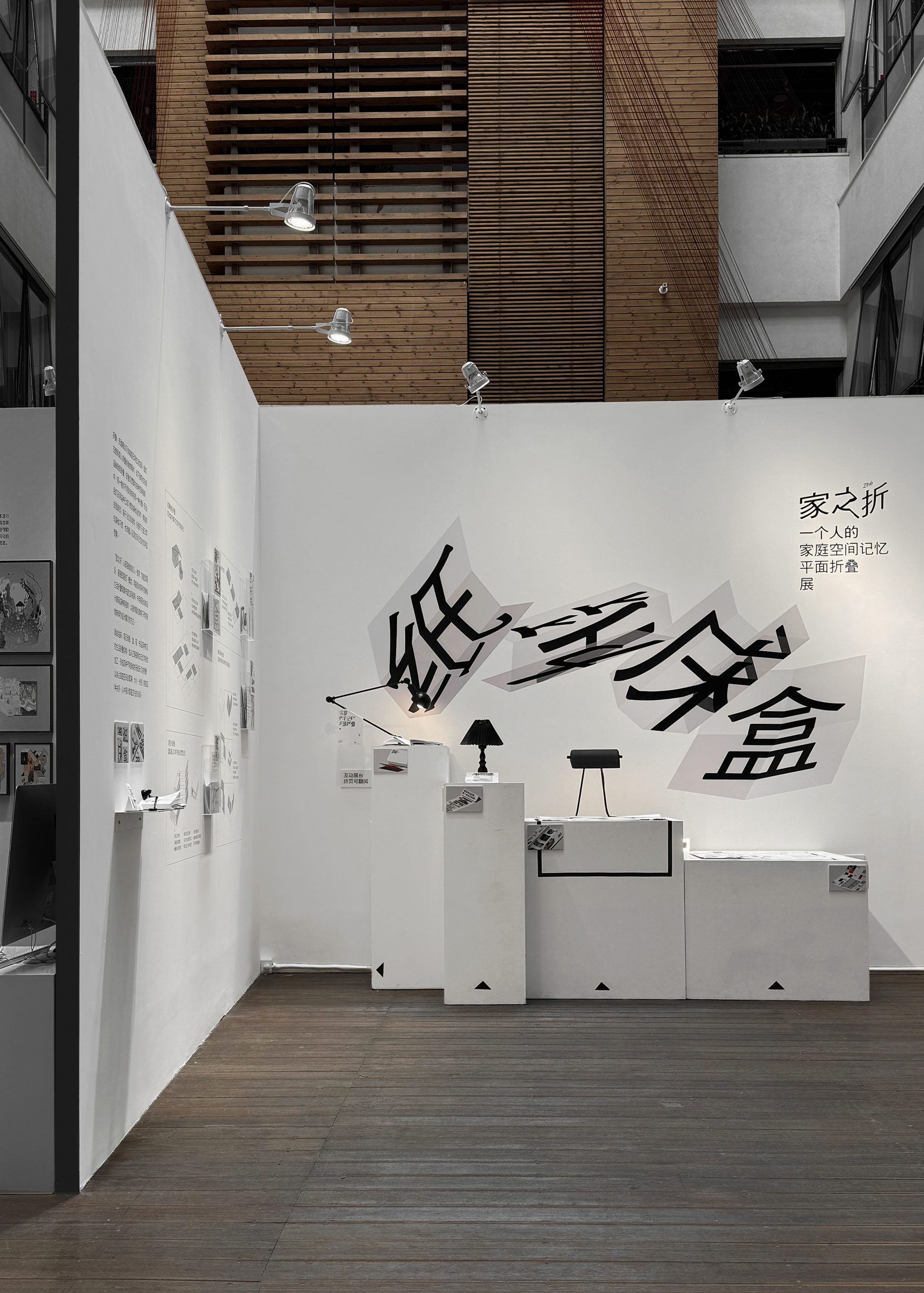

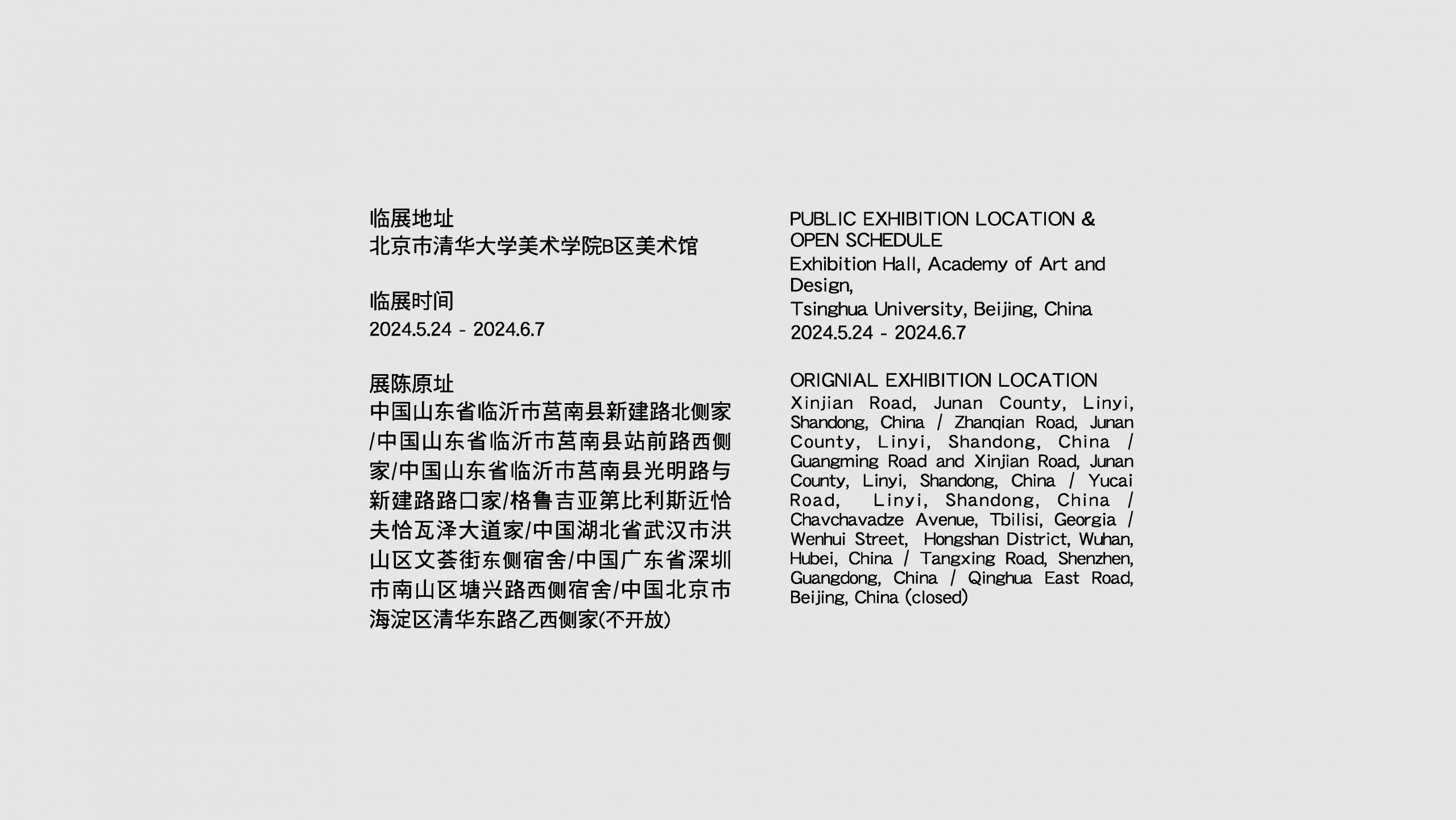
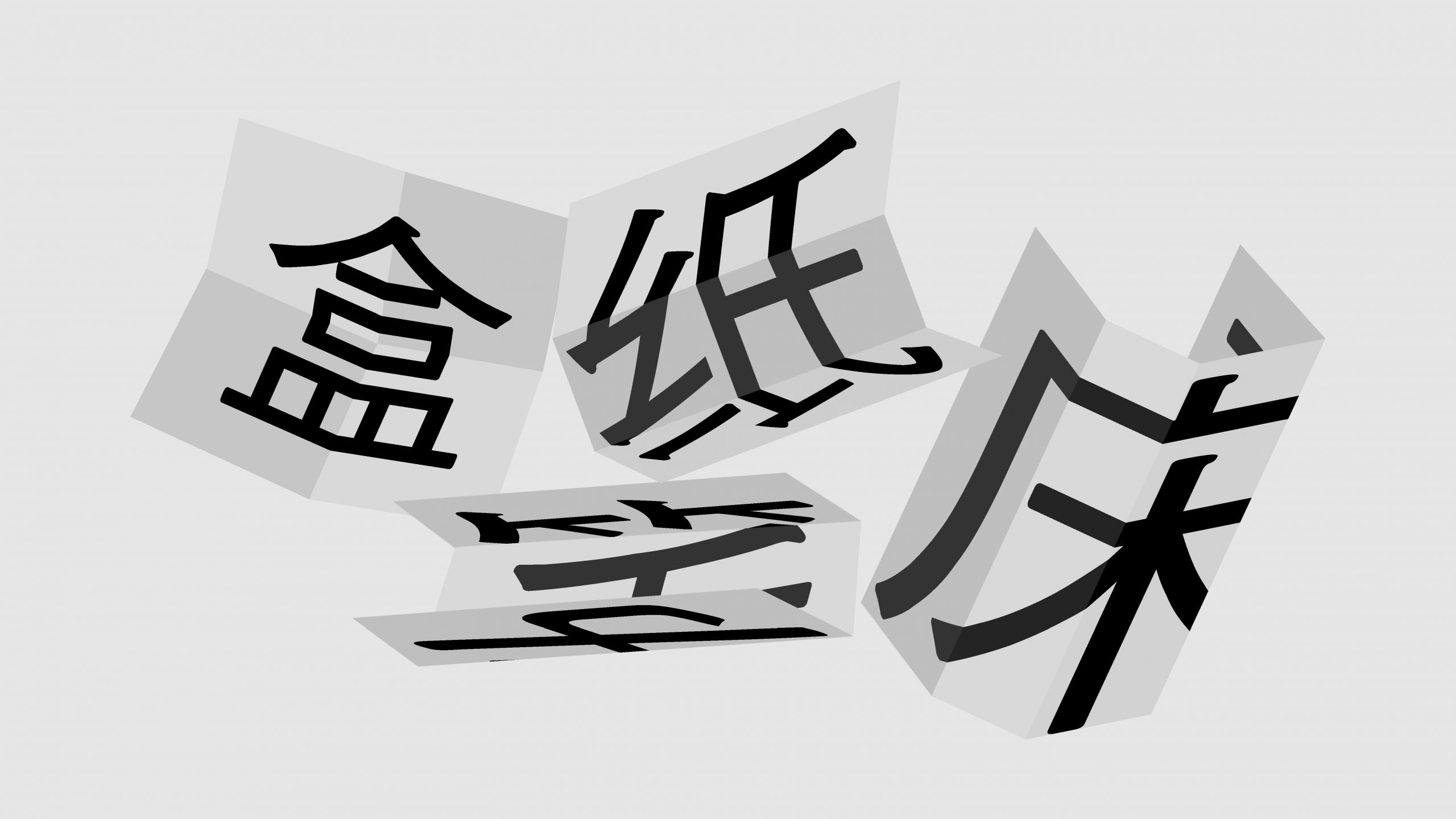
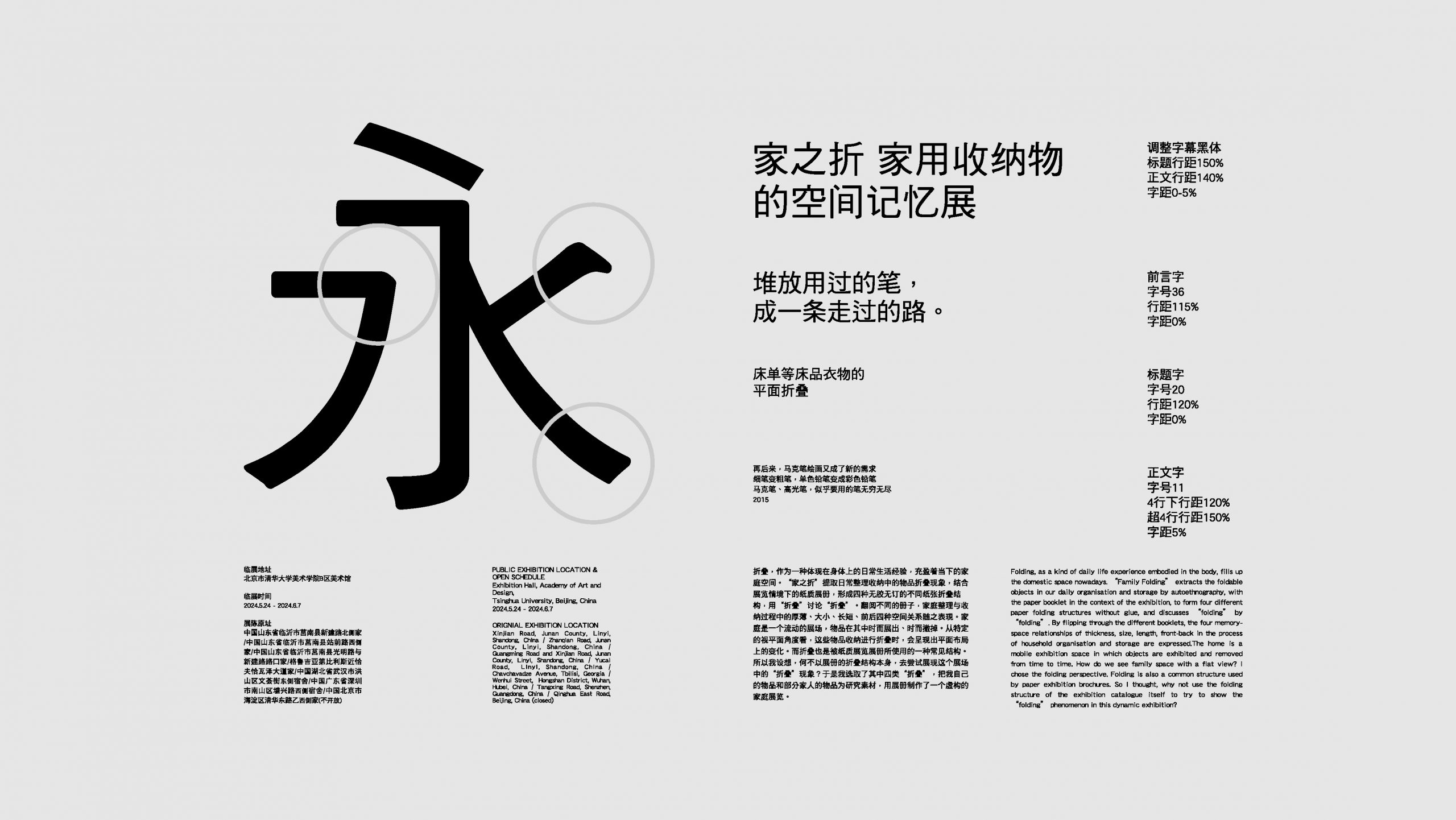

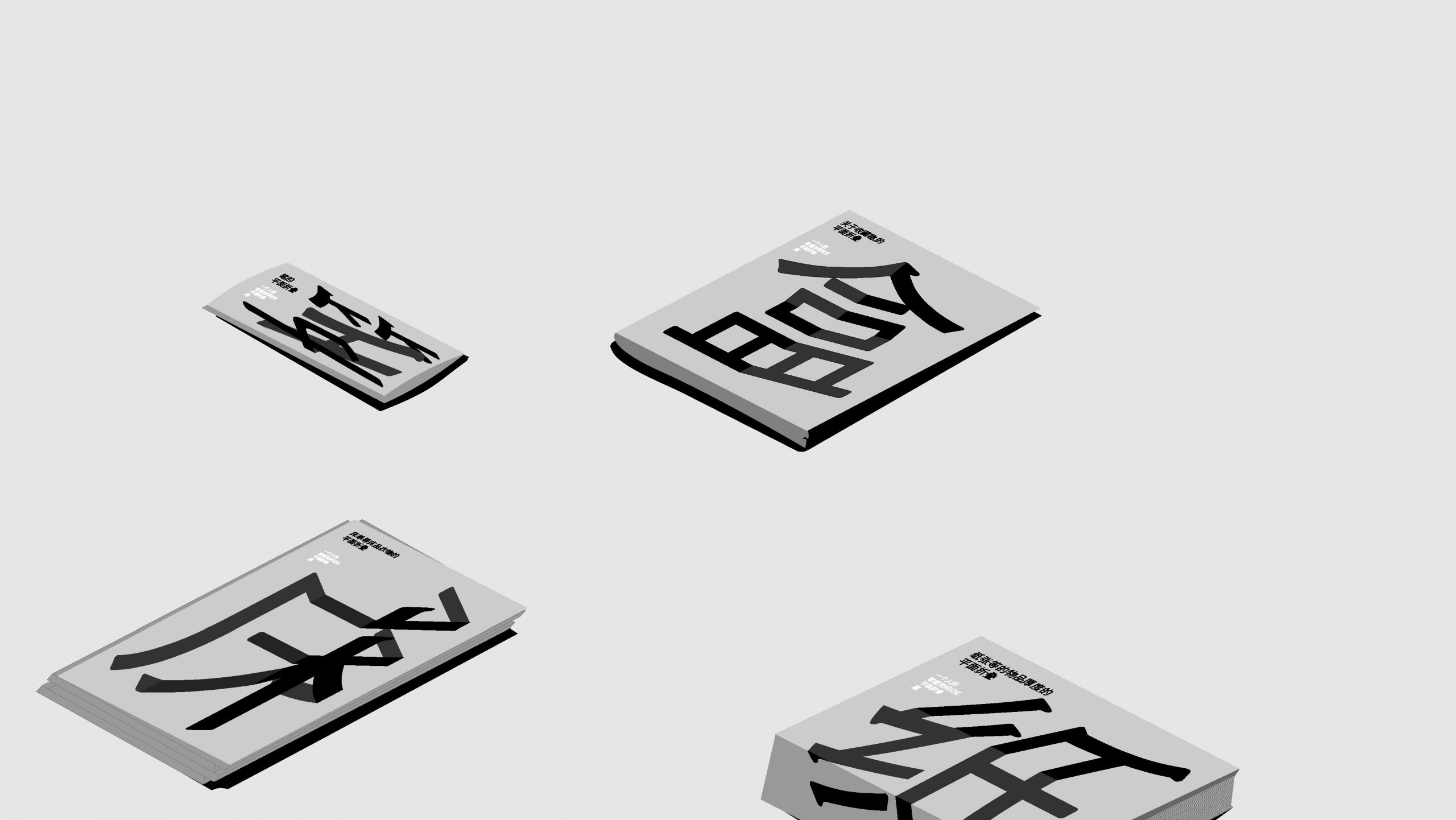
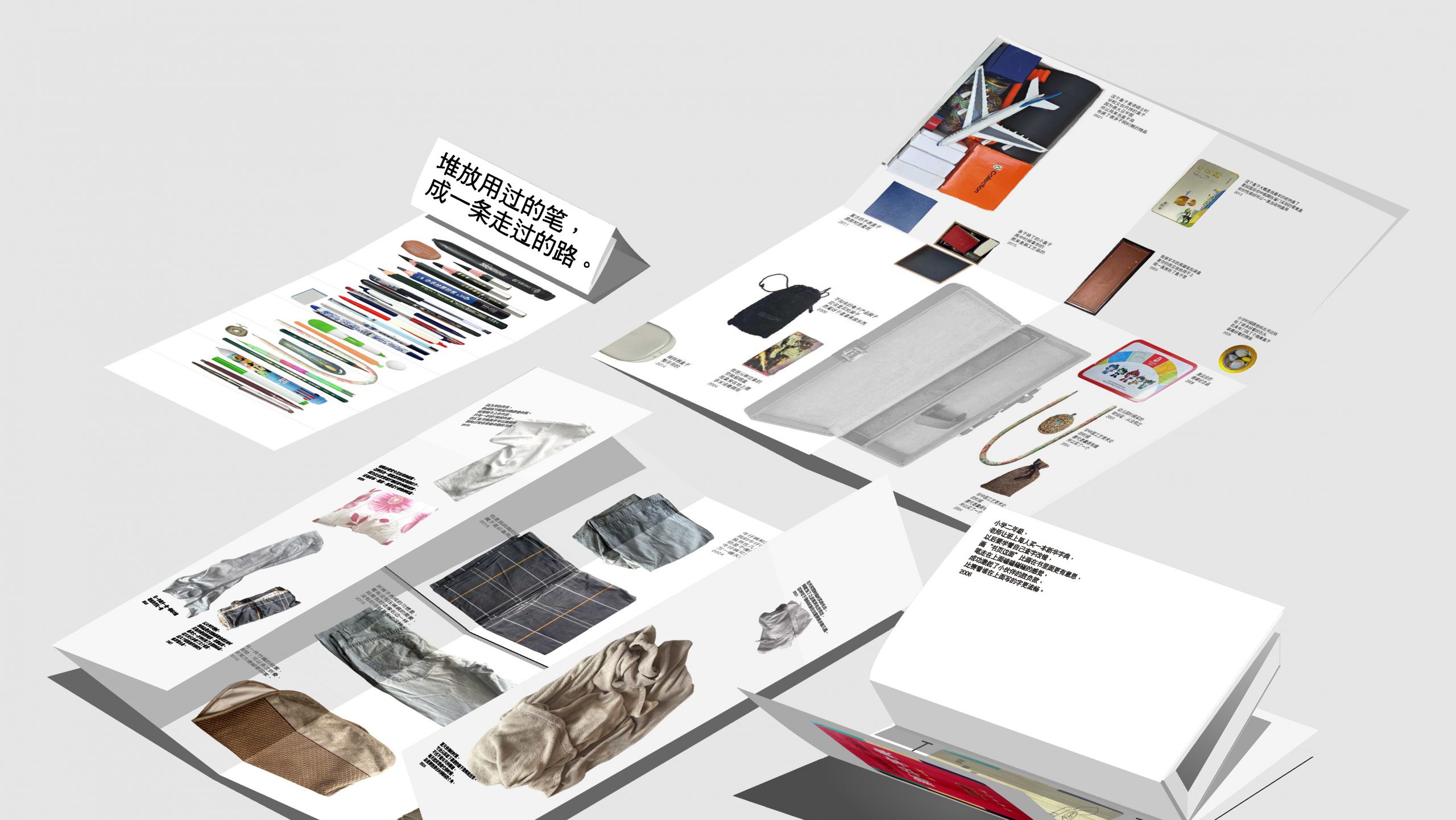
① 厚-薄空间:堆放物品时的侧面
记录事件、收集物件,让书本变厚、让包袋变鼓,观看这些物品的侧面时,我们从每一页的具体记忆跳出来,转而回想它的来源和背后故事。所以从这个角度出发,我把书脊“匚”结构与纸折叠进行结合,做出一本50张纸叠成的“书”,每一张纸的“匚”都比外面一张窄一些,摞起来,就码成了一本书的形态,但实际它每一页都是分开的;翻阅时,先看到物品的封面、再看到印在侧边的物品侧面,讲述也展示在同一面。而叙事上,从厚到薄的排列顺序,将我从小到大的记忆打乱。
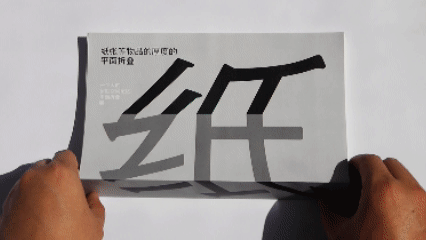


② 大-小空间:物品被拿出盒子时的变化
收藏各种物件的盒子里,我们会按照“能不能放进这个空儿”的空间逻辑放物品;而从盒子拿出这些物品时,盒子周围的空间被物品一点点填满的同时,不同时间的物品也会被“随机”地摆在一起。为了体现这种变化,用纸张的垂直交叉折表现“随机”的展开;每一次打开,每一道纸折痕与盒盖盒体交界处相重合,盒子内的物品会在下一页被拿出,更小的盒子打开-拿出同样如此;叙事上,对物品的描述随着物品被拿出而分层展现,比如我的大玩具会放在大盒子里,因为大所以更先出现,而徽章之类的小物件则在更小的盒子里,更小则靠后出现。
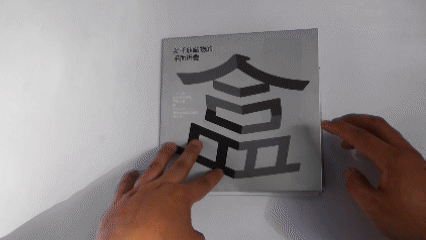
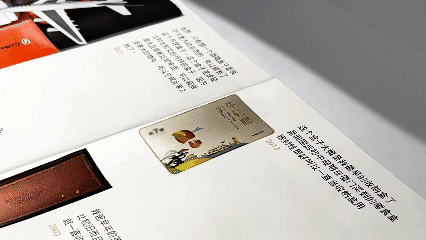
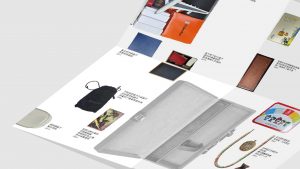
③ 长-短空间:笔堆起来的一排
成长过程中会反复打开装笔的笔盒笔袋,不同人生阶段打开的笔盒内部也会有不同的笔,把这些不同时期打开的盒子并置,形成的是一条笔形成的道路。用连续的纸张卷折体现笔盒打开的过程;翻阅时,单次折的是打开笔盒内部,前后折叠则是笔盒结构的复制和笔的变化,比如小学玩具笔、初中钢笔、艺考画笔、大学鼠标指针,形成一条与爱好、职业相关的路,长与短的空间逻辑也在其中展现。
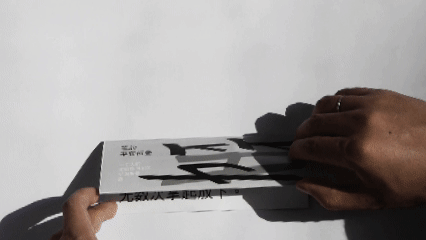
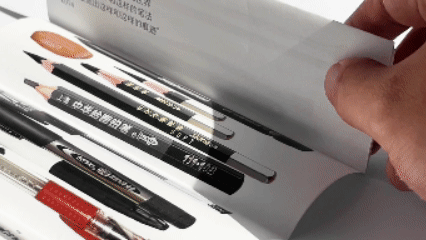
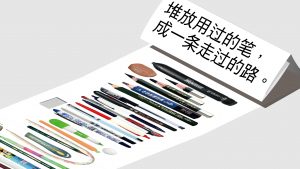
④ 前-后空间:使用频率不同的收纳
椅背上会出现随意折叠的衣物、柜子里会放置折叠整齐的被单、床底会放着压缩了的真空折叠袋——不同收纳空间的使用频率不同,里面床品衣物的形态也不同。我将这种空间理解为使用频率所造成的前与后,高频的折叠在前、低频的折叠在后。与垂直交叉折不同,模拟被单的开门折,它展开时有一块居于中心的平面空间,每次“开门”都会进到下一层。翻阅时,随机折痕、到规整折痕、到无折痕,用这个结构展现我和家人使用的床品衣物的频率,以及其中的喜好和习惯,例如,黑灰颜色常用,父母结婚时绣花床单和不应季的不常用,等等。
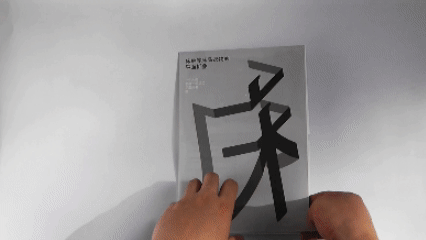

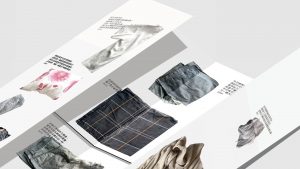
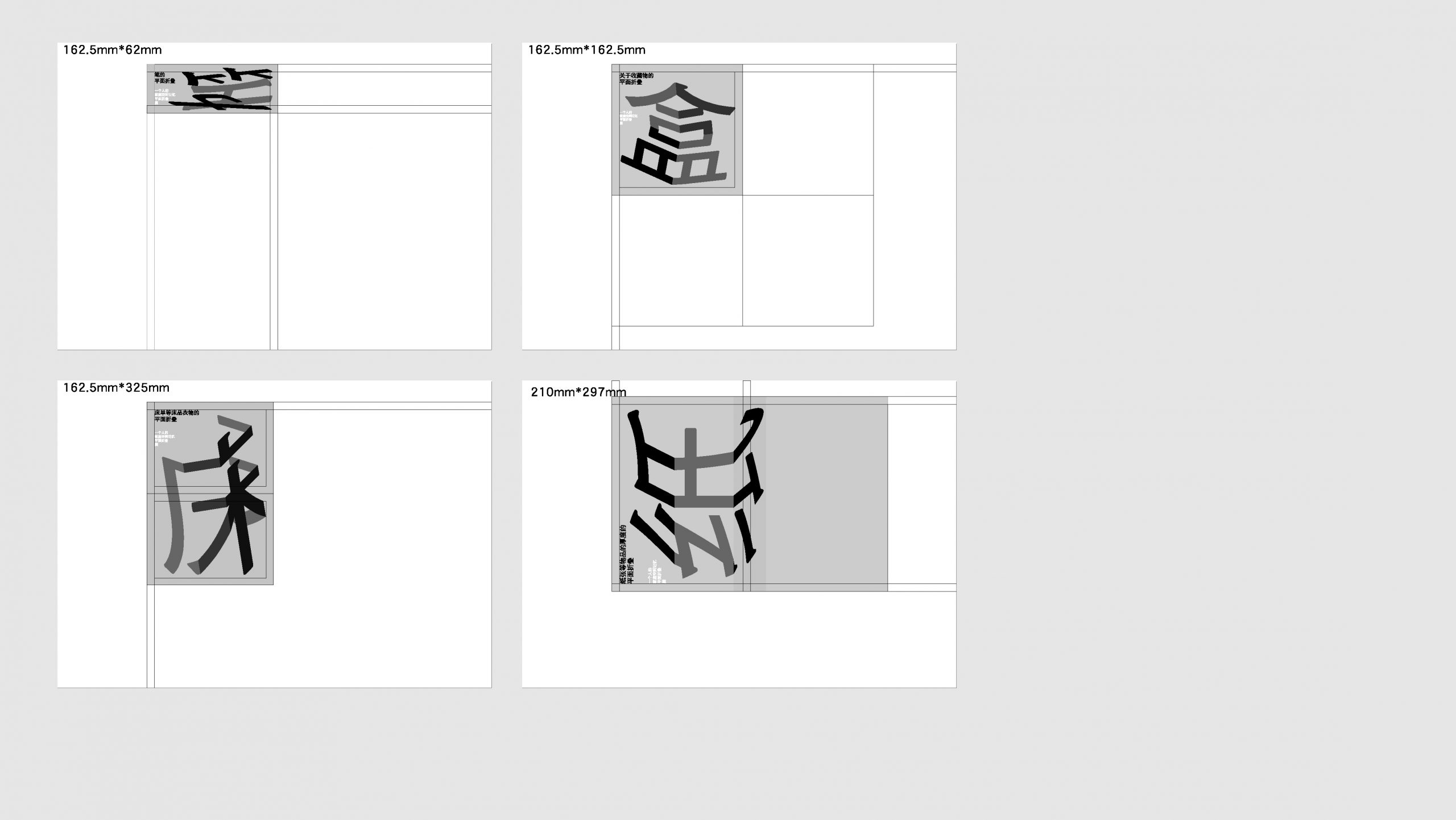
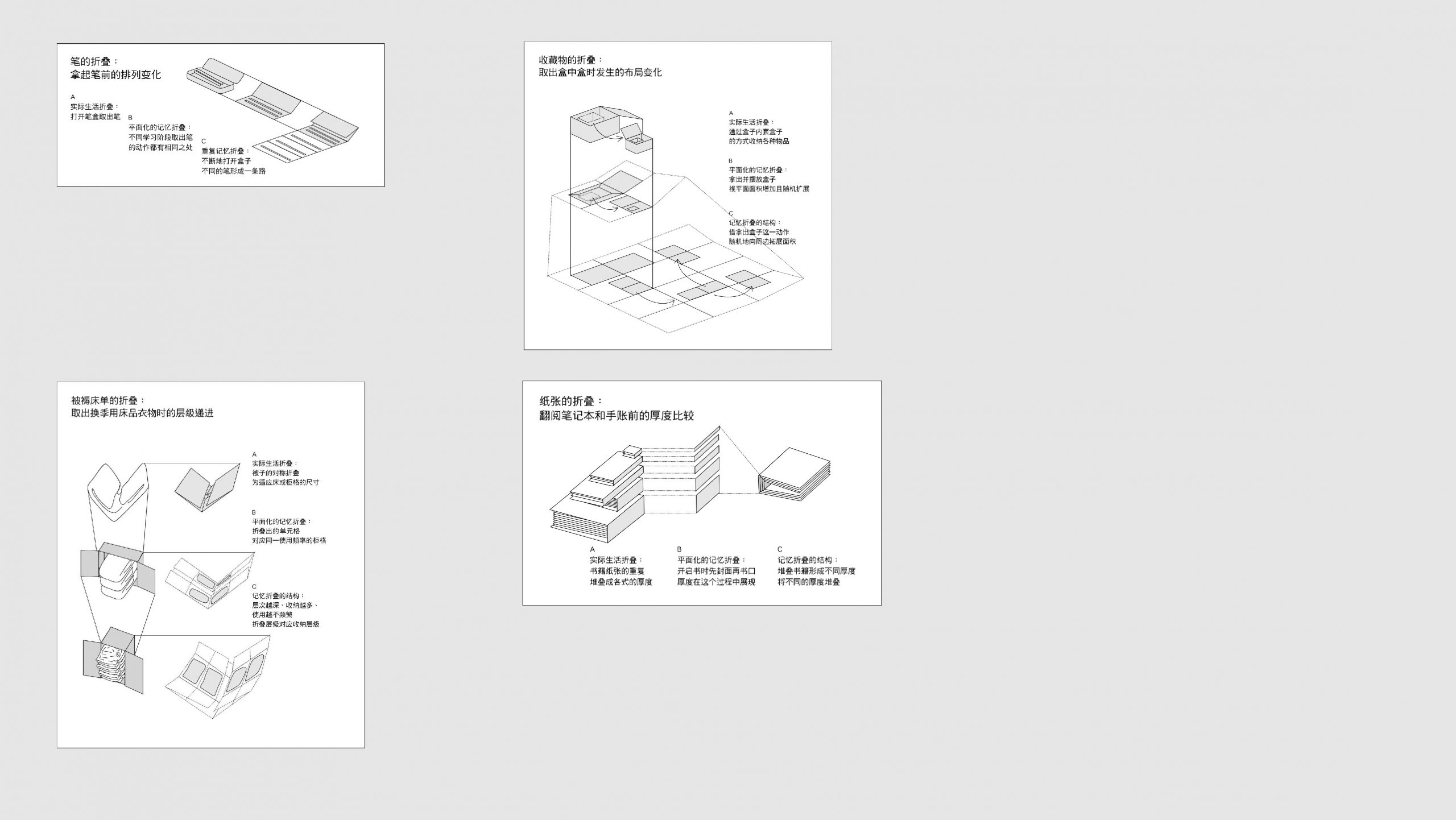
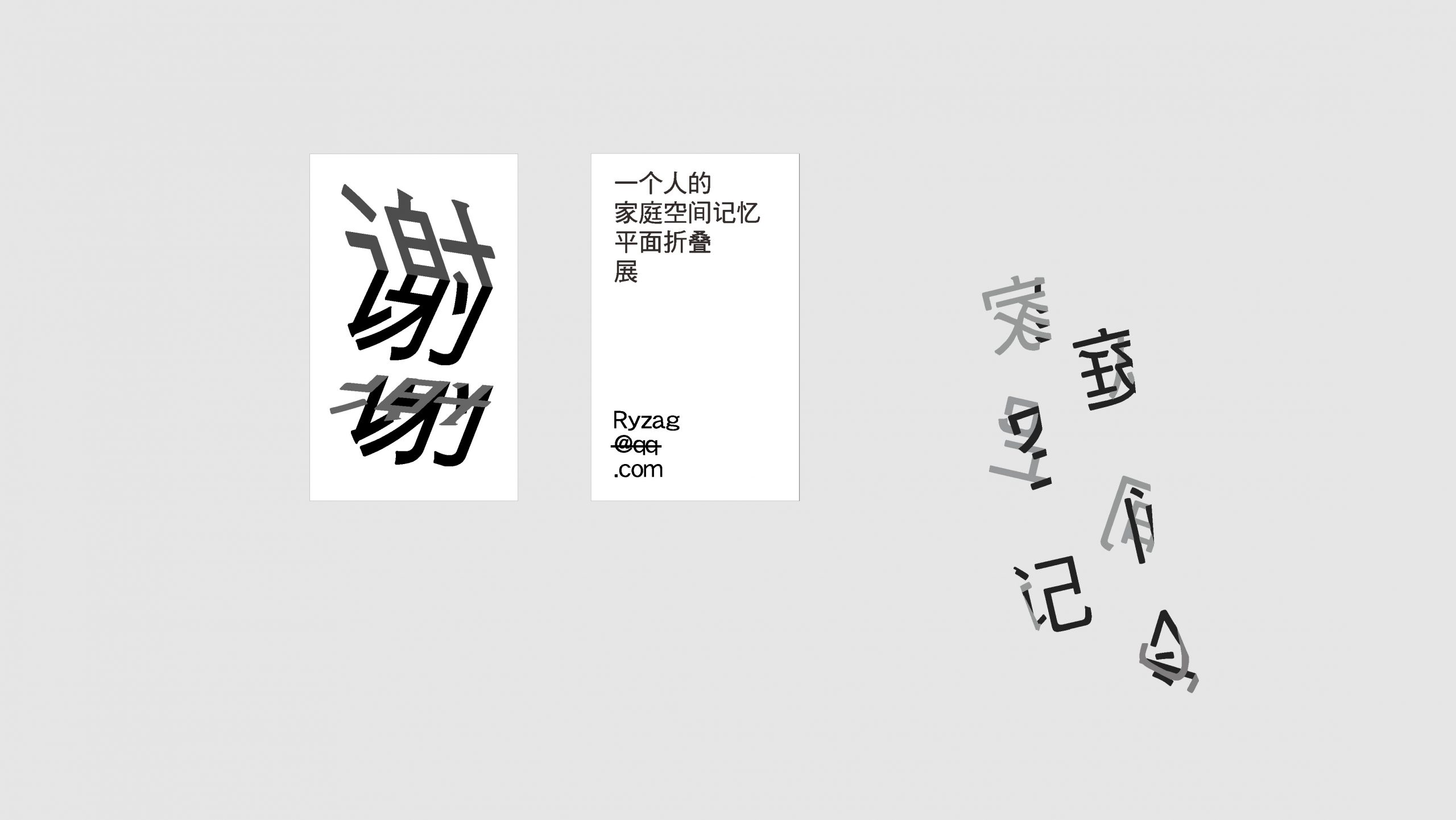
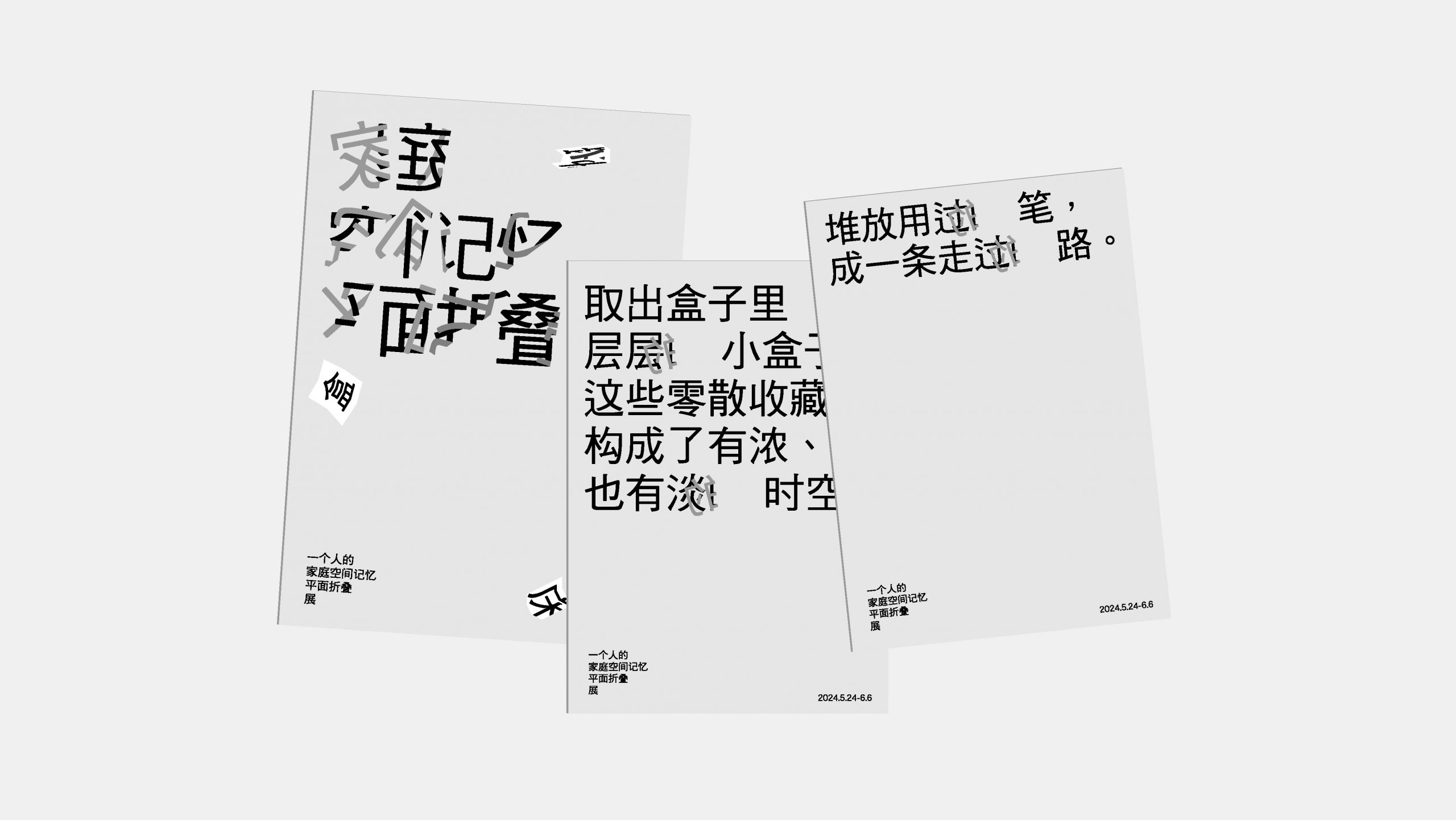

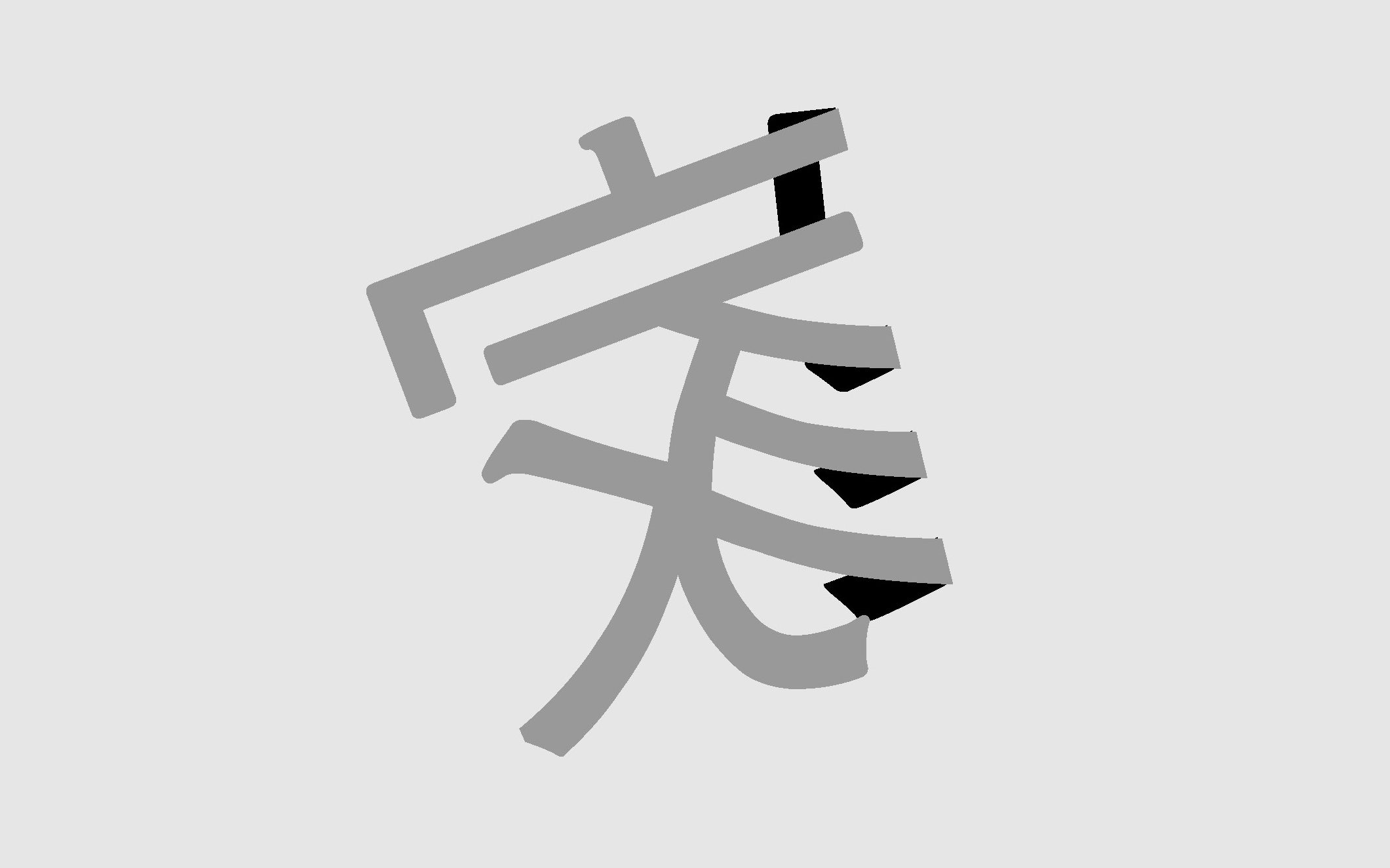
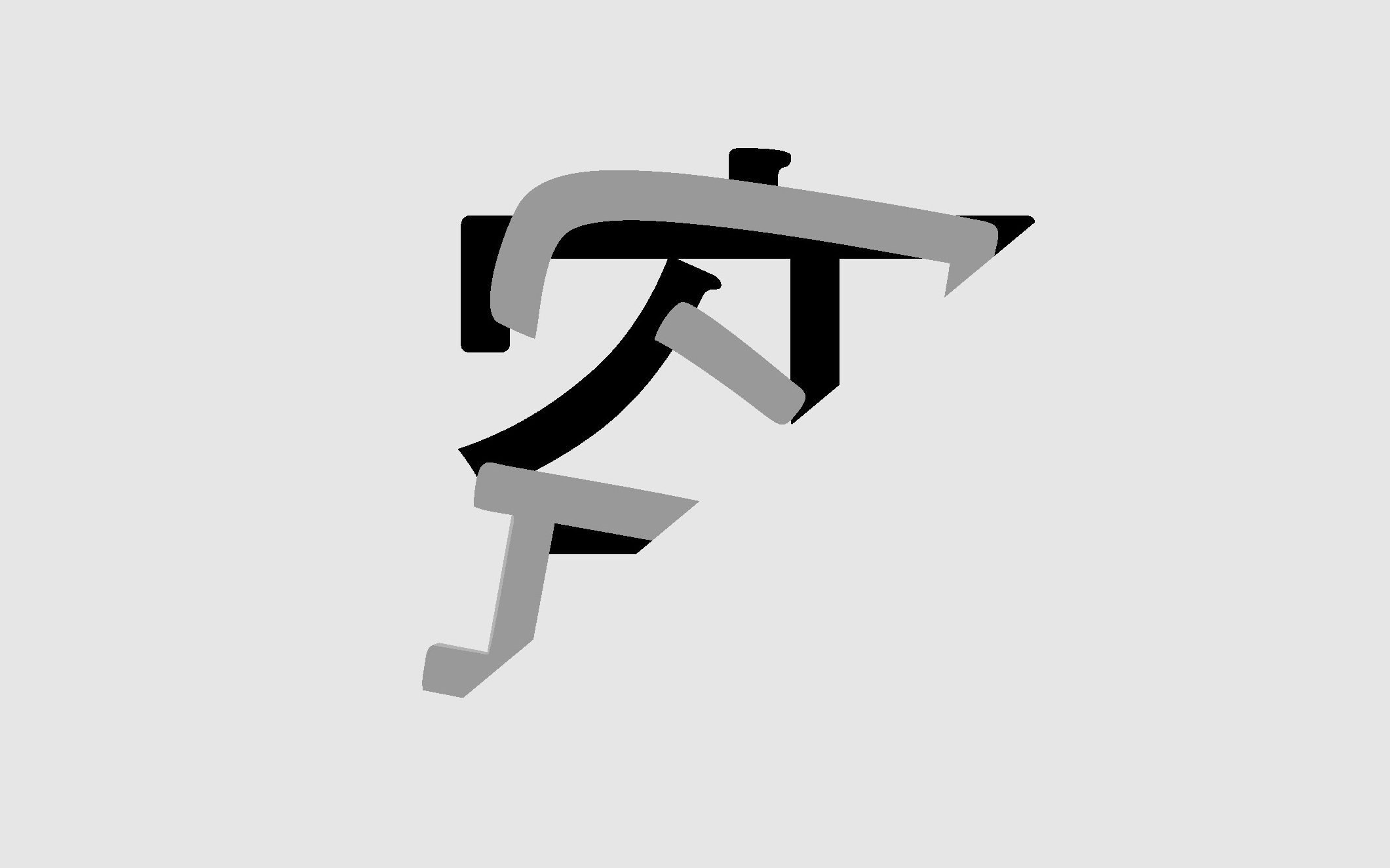
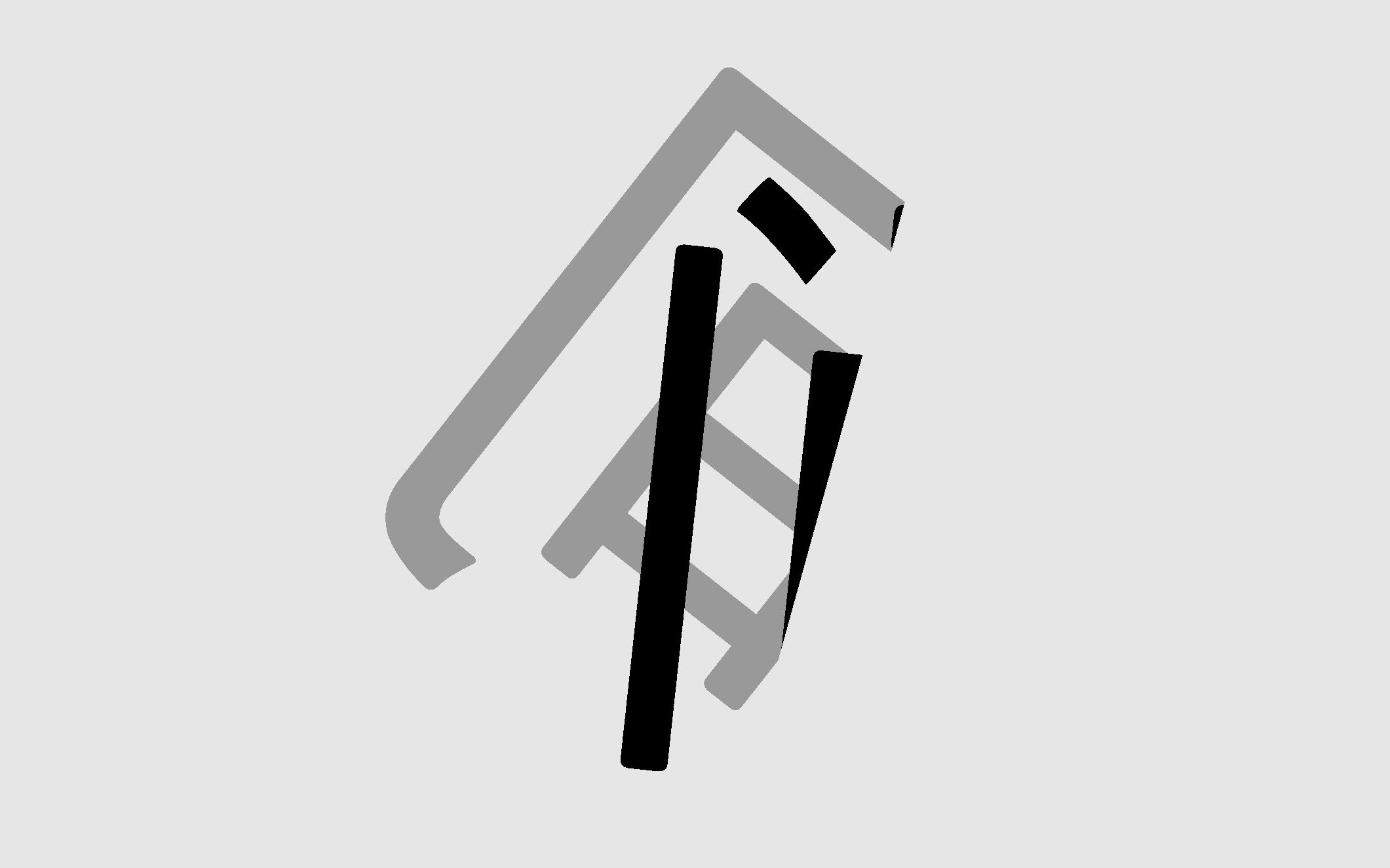
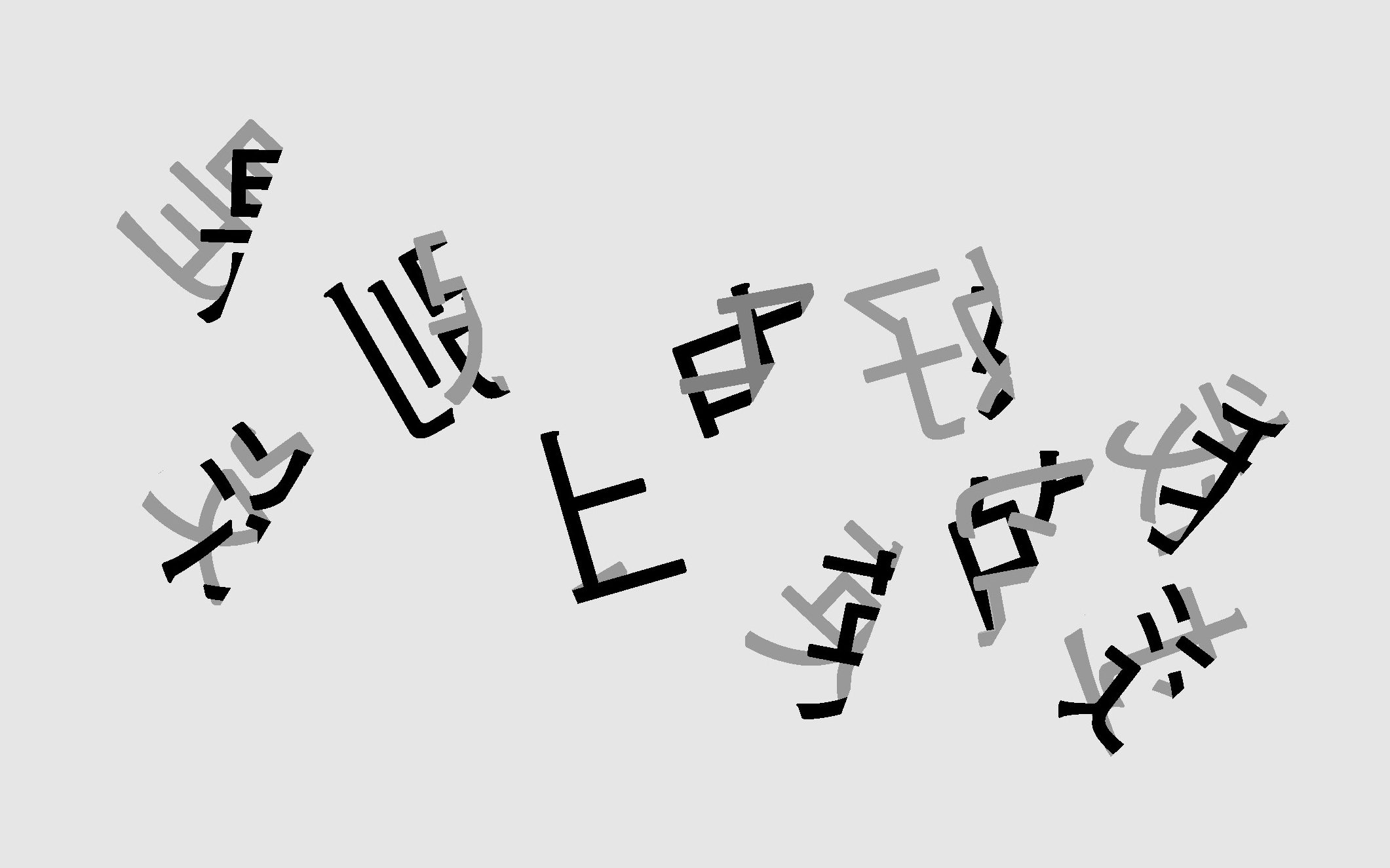
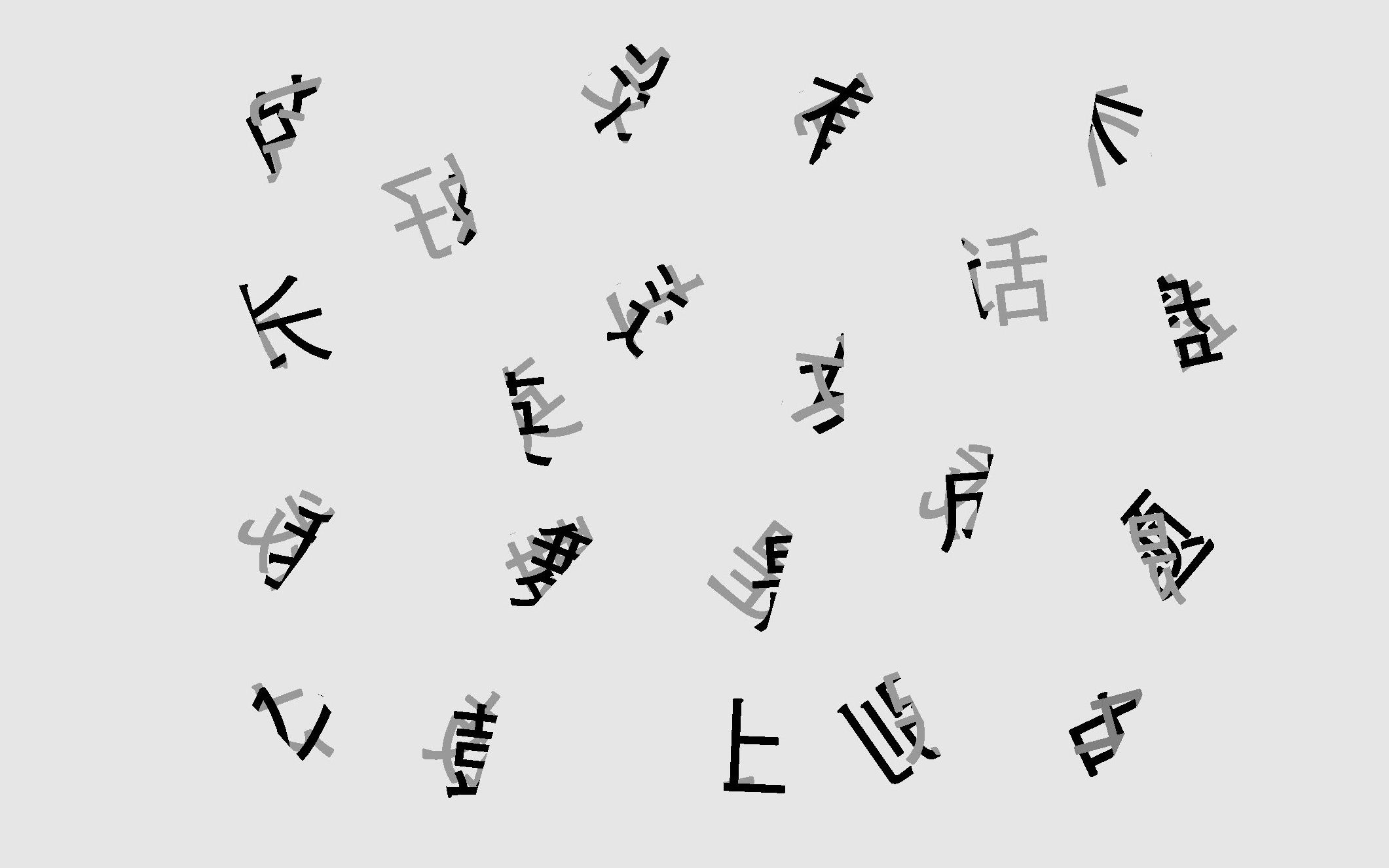
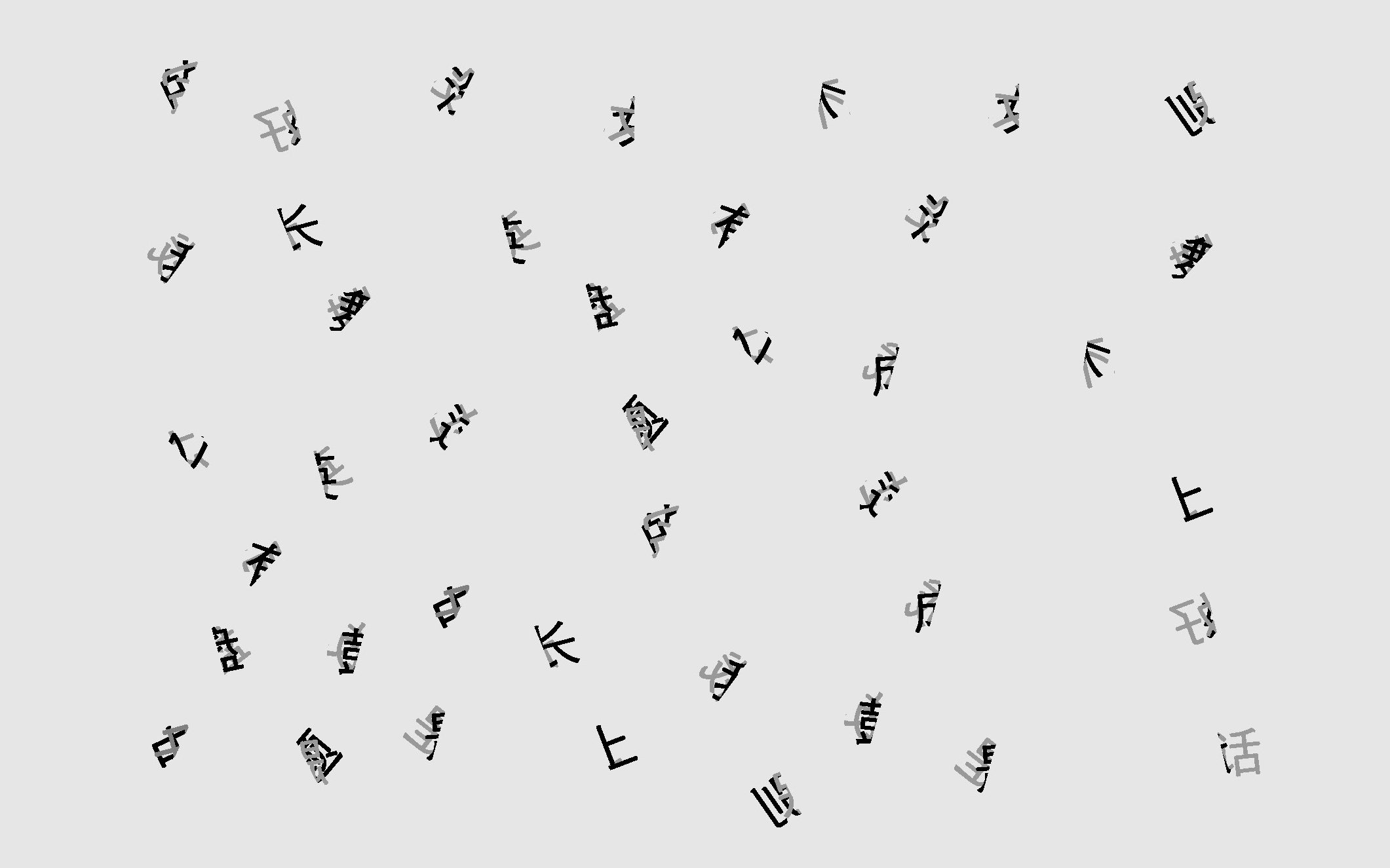
展览突出视觉和互动、弱化衍生品。右墙是互动区,前有四个不同尺寸的展台,用来放置展开后的纸张,展台上用黑色纸胶带画出不同面积的线条,引导观众发现线条与展册开合的关系,配以和主题物相关的电灯;左墙用等轴测图介绍空间的逻辑关系,并展示衍生品。

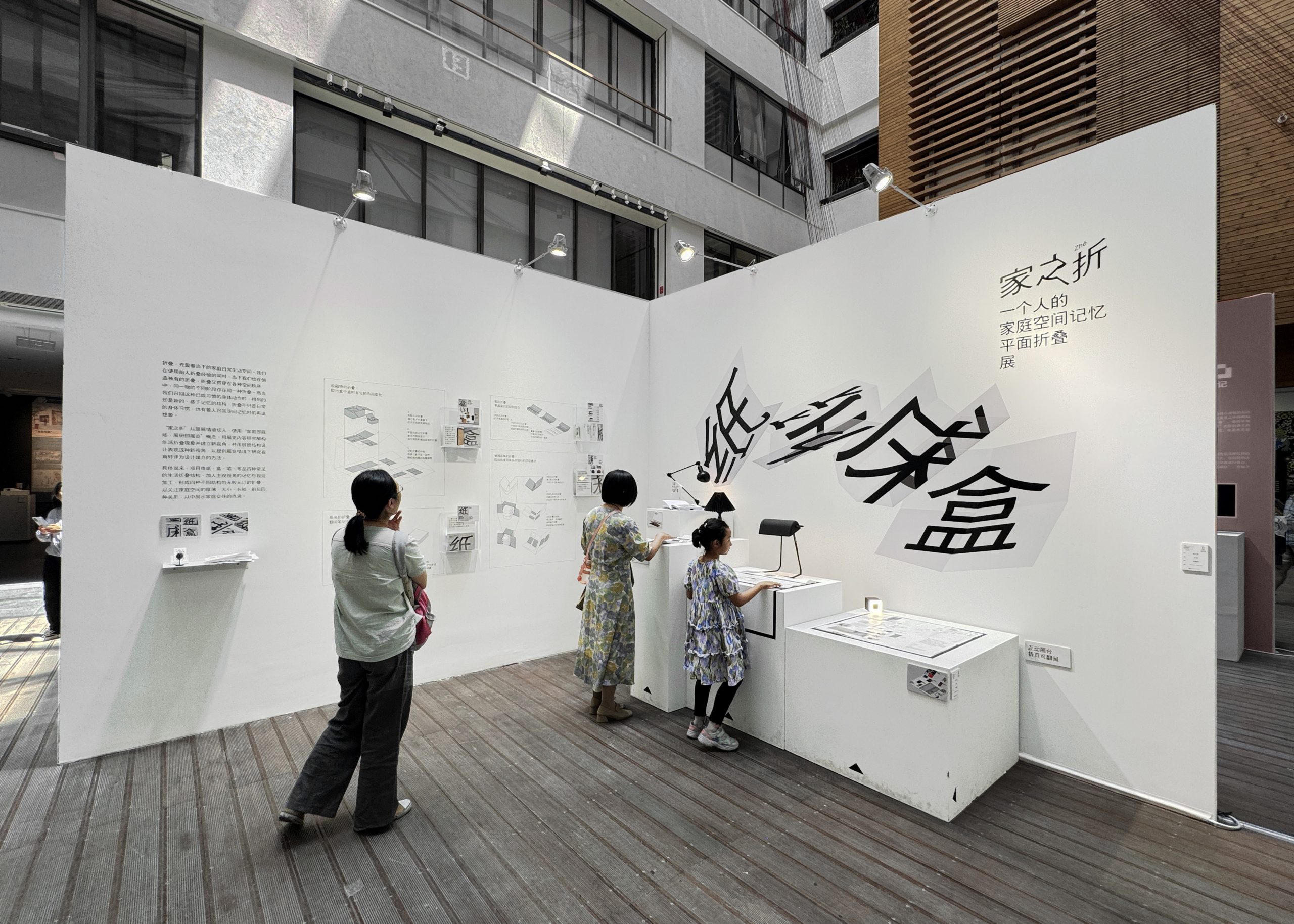
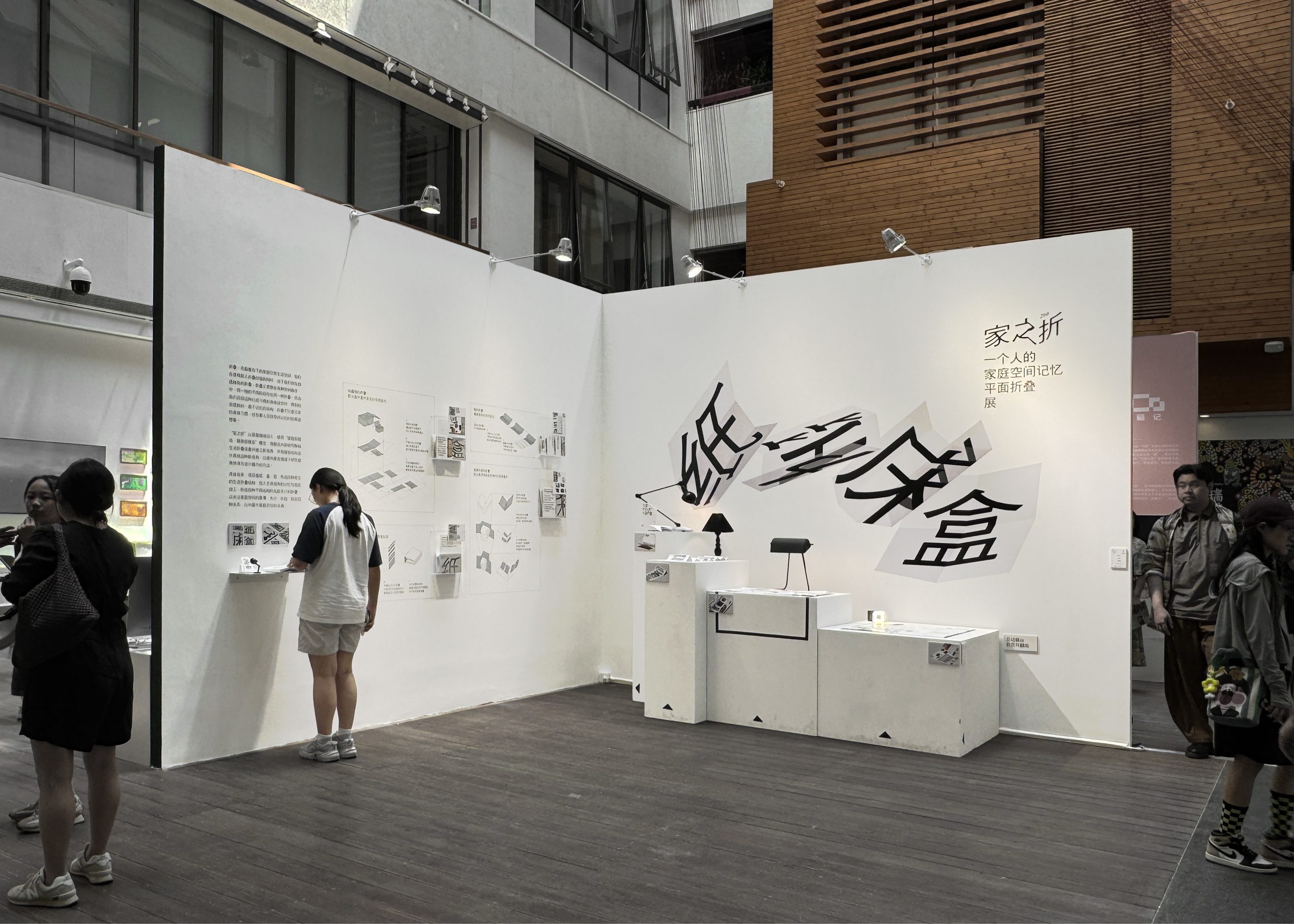
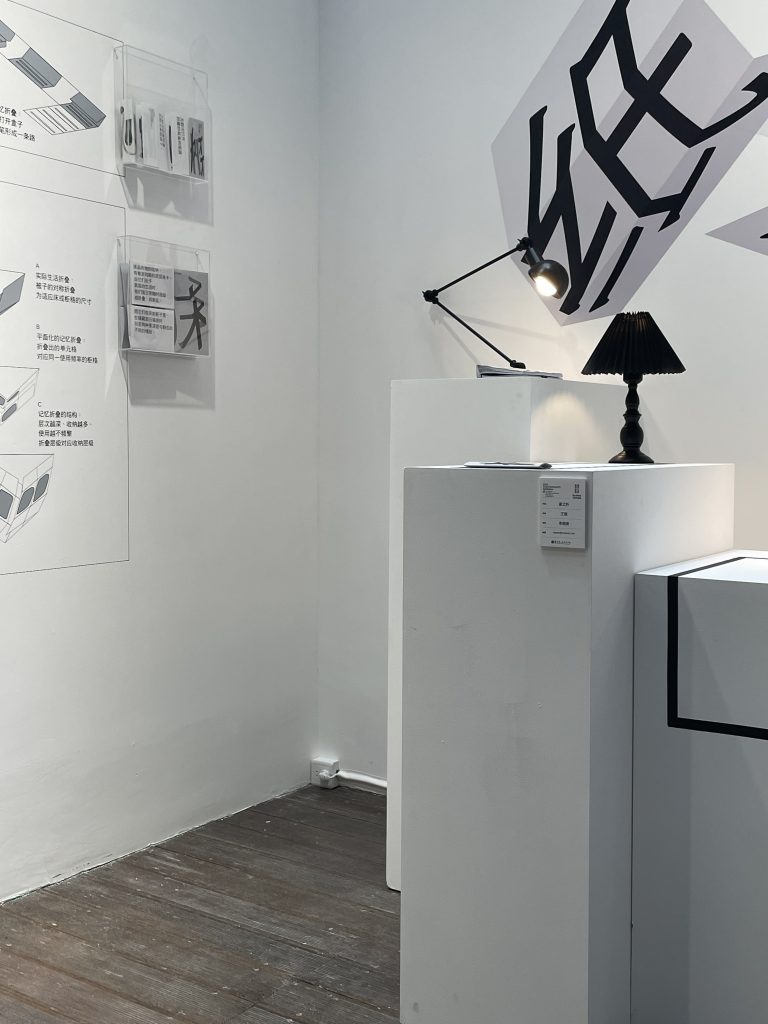
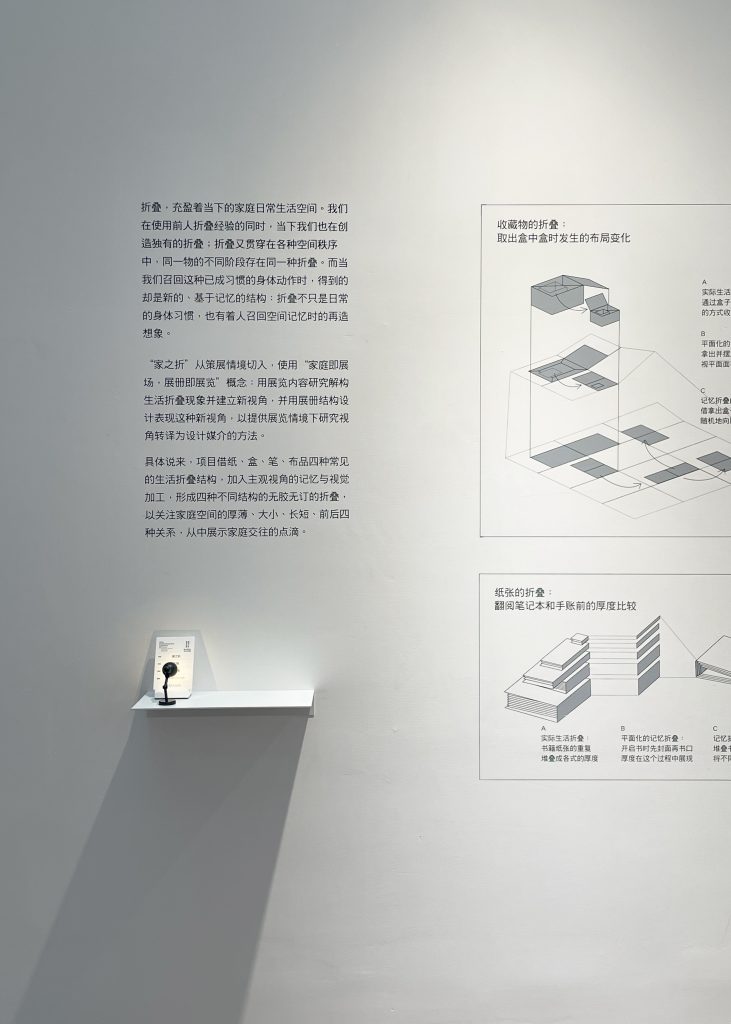
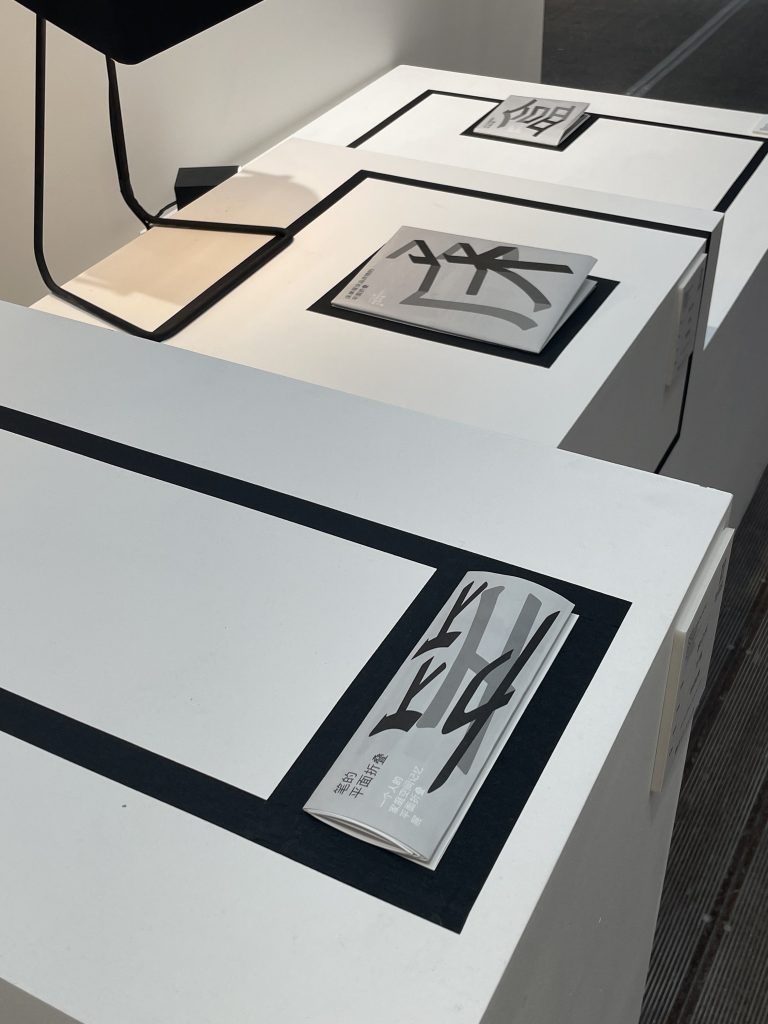
版权协议
Copyright
All design concepts and creative work contained herein are the property of the project team and were created by us. The client retains the sole right to approve, reject, or modify any element of this proposal for final implementation.
概念
Concept
Wang Rui
设计&策展
Design & Curation
Wang Rui
指导
Director
Li Degeng
素材来源
Content Source
Tian Zhen, Wang Mingfei, Tian Zhaokuai, Liu Wencai, Wang Renye, Du Shuxiu
生产支持
Producing Support
Meicaida Printing, Sanrenjiang Showcase, Jingren Paperlogue, Senluo Wanxiang Paper, Fengshang Printing
特别鸣谢
Special Thanks
Yuan Qi, Yu Bin, Yue Jian Li, Zhou Tao, Xia Yanfeng, Cai Qizhen, Zhang Kejia, Li Ye, Huang Yijie, Wang Shaofan, Wang Chen
论坛
FORUM
中央美术学院建筑人类学学术论坛口头报告
The 10th Forum on Architectural Anthropology & CAFA Forum on Architectural Culture Oral Presentation
展览
EXHIBITION
2024/5/24 – 6/6
家之折,清华大学美术学院研究生毕业展
清华大学美术学院美术馆大厅,中国北京
Family Folding: Flat Folding Exhibition of Family Spatial Memories, Graduate Exhibition of Academy of Art and Design
AAD Art Center Hall, Tsinghua University
Beijing, China
报道
REPORT
奖项
AWARD
2024
中国建筑工业出版社
清华大学美术学院毕业生作品集
Graduate Portfolio of Academy of Arts & Design, Tsinghua University
引用
REFERENCE
Wang Rui. Structural Translation from Family Daily Storage to Exhibition Booklet Folding [D]. Tsinghua University, 2024.
时间戳
Time Stamp
2024/6/6